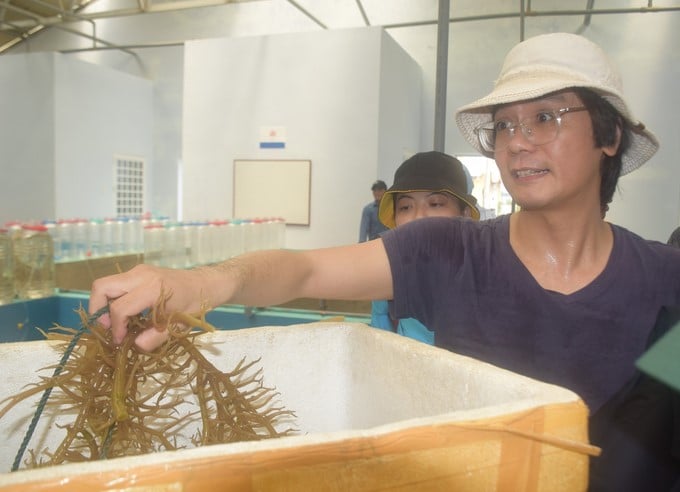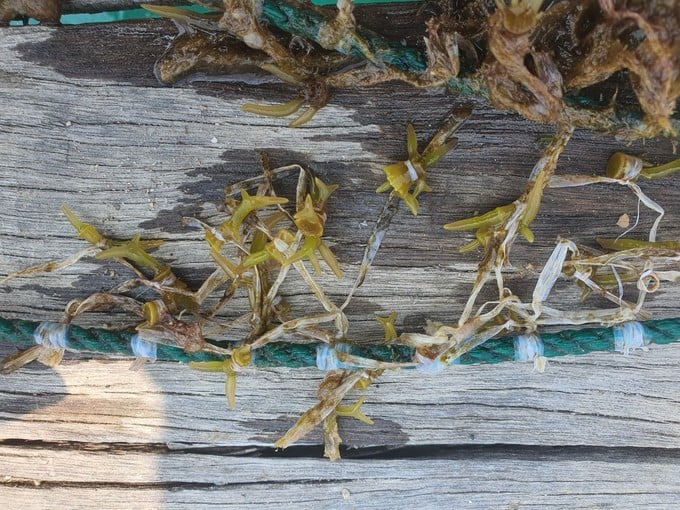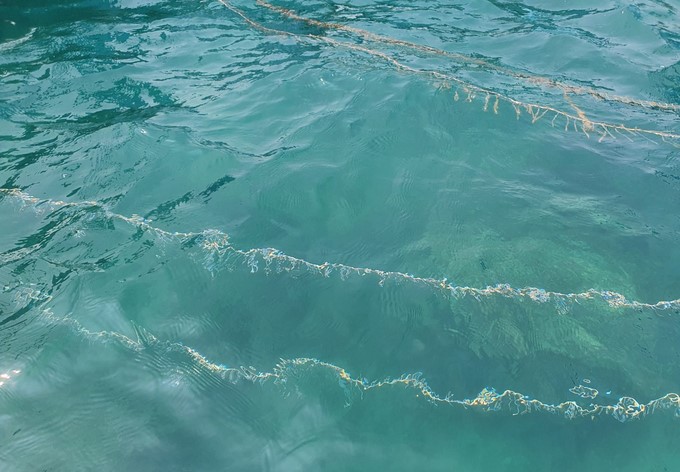May 24, 2025 | 16:22 GMT +7
May 24, 2025 | 16:22 GMT +7
Hotline: 0913.378.918
May 24, 2025 | 16:22 GMT +7
Hotline: 0913.378.918

Growing seaweed in Binh Dinh requires using mature varieties, 15–20 cm long, to harvest before the rainy season. Photo: V.D.T.
In early April 2023, the Binh Dinh People's Committee approved the topic of research, development, and deep processing of some seaweed products in the direction of improving quality and developing into a value chain in Binh Dinh province. This topic was assigned by the functional branch to the Binh Dinh Agricultural Extension Center to implement. This is the premise for the future development of the seaweed farming profession.
The assigned unit will investigate the yield and harvest season of seaweed varieties in Binh Dinh. Research and develop some seaweed species suitable to local conditions in combination with research and high-tech application in post-harvest treatment, preliminary preparation, and processing of some products with added value from seaweed, ensuring food quality and safety in the direction of improving quality and developing into a value chain.
"We were assigned to study the production process of three seaweed varieties, namely cottonii, Gracilaria, and sea grapes, in Binh Dinh waters by the vegetative reproduction method. Research on the commercial farming process of the three above-selected seaweed species with a yield of 30–40 tons fresh/ha is needed to ensure economic efficiency. Research on the technological process of perfecting post-harvest treatment and processing into products including nutritious seaweed powder, vacuum-sealed fresh sea grapes, and bottled seaweed juice. Develop a set of basic standards for seaweed products that meet the technical criteria, ensuring food safety according to regulations. Design and build a set of labels for seaweed products; build a consumption chain linkage model of products processed from seaweed," said Mr. Tran Quang Nhut, Deputy Director of Binh Dinh Agricultural Extension Center.
According to Mr. Tran Van Vinh, Deputy Director of Binh Dinh Sub-Department of Fisheries, growing seaweed in inshore waters is a condition for ensuring livelihoods for fishermen in sea villages. Seaweed is also a highly commercial product, so it will bring economic efficiency. The advantage of the seaweed farming profession for fishermen in fishing villages is that the farming technique is quite simple; no highly qualified labor is required; seaweed growers only need to be diligent to do it.

Seeds are tied to a rope, ready to be brought to the sea. Photo: V.D.T.
"When growing seaweed, growers do not need to feed, fertilize, or inject drugs. Seaweed growers just need to visit and clean items such as bags and packing clinging to the seaweed every day. This work aims to avoid the seaweed being broken and create a well-ventilated farming area for the seaweed to absorb light and oxygen to develop. When farming seaweed, farmers will be responsible for protecting the farming water area by not allowing near-shore fishing vessels to operate, so they will protect the ecological environment of the waters," said Mr. Tran Van Vinh.
According to Mr. Phan Tuan, Head of Quy Nhon City Economic Department (Binh Dinh), the provincial agricultural sector is building a test model of commercial seaweed farming in Nhon Hai commune (Quy Nhon City). If this model is successful, the city functional branch will replicate it in three other coastal localities, namely Nhon Ly commune, Nhon Chau commune, and Ghenh Rang ward, but mainly in Nhon Hai commune.

Seaweed seeds of Mr. Nguyen Ton Xuan Sang, Director of Nhon Hai Tourism and Fisheries Service Cooperative (Quy Nhon city, Binh Dinh), when they were just brought to the sea. Photo: V.D.T.
Initiating the work of developing the marine farming profession in Binh Dinh, Mr. Nguyen Ton Xuan Sang, Director of Nhon Hai Tourism and Fisheries Service Cooperative (Quy Nhon City), pioneered the trial planting of 12,000 seaweed seedlings. According to Mr. Sang, 12,000 of these seaweed seedlings are supported by DBLP Company (Phu Yen) for trial production.
The above-mentioned seaweed seeds were brought to Binh Dinh at a time of rough seas. In addition, at that time, there was no technique to tie the seaweed seeds to the rope and no raft to hang the seaweed ropes, so it was not possible to bring the seaweed seeds to the sea. They must have been raised on shore for more than 2 months. By the beginning of February 2023, the above-mentioned seaweed seeds were all tied to the rope, and Mr. Sang also bought a raft, so he was able to bring the seaweed seed to the sea. There were then only 10,000 plants left.
"Initially, 10,000 seaweed seedlings were raised in more than 10 plots; each plot has an area of 5 m2. After releasing the seed into the sea about 20 days later, I extracted the seaweed plant to replicate. At first, I put a net around the seaweed planting plots to prevent fish from eating the young seaweed. The net is a kind of net with a mesh size of about 1–1.5 cm to prevent small fish. When the seaweed was mature and no longer afraid of fish eating it, I removed the net and released the weeds into nature.
The seaweed ropes are arranged at a roping distance of 0.5–1 m, leaving space for the seaweed to grow. One bunch of seaweed seeds is tied together for about 100g; this bunch is about 20cm away from the other. The seaweed ropes are arranged about 5–6 cm from the water surface. If the seaweed farming water area is contaminated with sweetness or the temperature on the water surface is too hot, it is necessary to let the seaweed ropes sink deep down about 30–40 cm from the water surface to prevent the seaweed from dying," said Mr. Nguyen Ton Xuan Sang.

Products processed from seaweed are the destination of Binh Dinh after developing seaweed farming. Photo: V.D.T.
According to Mr. Sang, seaweed cultivation needs to be avoided for 3 months in the rainy season because of the rough seas. Through practice, Mr. Sang derives the experience that in Binh Dinh, if wanting to grow seaweed effectively, growers need to buy mature seaweed varieties with a length of about 15–20 cm. The time to bring seaweed seeds to the sea is before the Lunar New Year; farming until August of the next lunar year to harvest is to avoid the rainy season. If the harvest time is not in time to avoid the rainy season, the grower will lose income because the waves and wind will break the seaweed.
In Nhon Hai, there is a forest of sargassum on the seabed, proving that this sea is suitable for seaweed to grow, so seaweed cultivation will definitely be effective. The commercial cottonii currently costs VND 3,000–4,000/kg fresh, bought at the place of production, which is equivalent to about VND 28,000–30,000/kg dry. In winter, because seaweed no longer produces output, the price rises to VND 40,000–50,000/kg dry.
Mr. Sang calculates that the commercial seaweed is covered by DBLP Company, so there is no need to worry about the output. Each year, one hectare produces 30 tons of seaweed, and the average price of fresh seaweed is 4,000 VND/kg, so the grower has a revenue of VND 120 million/ha/year. After subtracting the seed cost of about VND 20 million, the grower still has a profit of VND 100 million, which is not a small amount of income for the people of the fishing village.
"When seaweed farming gives high economic efficiency, near-shore fishermen in Nhon Hai will switch to this profession. Until then, each household that changes jobs should be provided with at least 2 ha of water surface to grow seaweed. In Nhon Hai, if we avoid the wave areas, the areas that have been assigned to tourism enterprises, and the coral reef protection areas, the area of seawater surface capable of growing seaweed is only enough for about 30 households. Consequently, the functional branch needs to survey and plan more new waters", Mr. Nguyen Ton Xuan Sang proposed.
Translated by Huyen Vu Thu

(VAN) The People's Committee of Tra Vinh province has approved an adjustment to the investment policy for the Green Hydrogen Plant project, increasing its area to approximately 52.76 hectares.
![Reducing emissions from rice fields: [2] Farmers’ commitment to the soil](https://t.ex-cdn.com/nongnghiepmoitruong.vn/608w/files/news/2025/05/05/dsc08881jpg-nongnghiep-140632.jpg)
(VAN) Clean rice cultivation model in Thuong Tan commune, Bac Tan Uyen district, is assisting local residents in achieving sustainable agriculture by substantially reducing costs, increasing productivity, and protecting the environment.

(VAN) At the conference to disseminate Resolution No. 68, AgriS introduced its digital agricultural ecosystem and reaffirmed its commitment to accompanying the Government in promoting private sector development and sustainable agriculture.

(VAN) 'Blue Ocean - Blue Foods' initiative is designed to restore marine ecosystems and establish sustainable livelihoods for local communities by cultivating a minimum of 1,000 hectares of cottonii seaweed in the first three years.
/2025/05/21/4642-3-112707_603.jpg)
(VAN) The V-SCOPE project has made direct contributions to three out of six pillars of the Comprehensive Strategic Partnership between Vietnam and Australia.

(VAN) Facing the threat of rabies spreading to the community, Gia Lai province urgently carries out measures to vaccinate dogs and cats on a large scale.

(VAN) Disease-free livestock farming not only protects livestock herds but also stabilizes production and livelihoods for many farmers in Tuyen Quang.